Holocaust Survivor Memoirs With Lesson Plans
Exploring the life stories of the Holocaust Survivors who volunteer or were volunteers at the Holocaust Memorial is an excellent way of connecting to the experiences of these remarkable people and the lessons their experiences have taught them. Below are links to six Survivors memoirs.
To further explore and learn from these memoirs a series of lessons plans have been created for grades 6-12. The series compares and contrasts the various experiences of the Holocaust Survivors.
Please click on one of the names below to access a specific lesson plan.
High School Holocaust Survivor Memoir Lesson Plan:
Allan Hall and Henry Flescher
Fred Mulbauer and Alex Gross
Victor Farkas and Allan Hall
Middle School Holocaust Survivor Memoir Lesson Plan:
David Merelstein and Henry Flescher
Alex Gross and Victor Farkas
Allan Hall and Alex Gross
You may also read the memoirs of an additional ten Holocaust Survivors by scrolling toward the bottom of this page.
ALEX GROSS
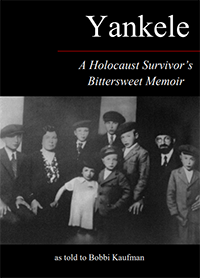
Alex Gross was born in the Carpathian Mountains of Czechoslovakia in 1928. When Hitler’s troops occupied Carpathia, Alex’s family was herded into the Munkoch Ghetto where they lived in a filthy brick oven. In May 1944, the family was locked into a cattled car for a six-day-long journey to hell. When the British Welfare Agency arranged to fly orphans to the British Isles, Alex and his sister and one brother were flown to Scotland. In 1949, Alex immigrated to the United States. In 1951, he joined the American Army. One by one, all his siblings came to the United States.
Click here to view Alex's memoir.
ALLAN HALL

Allan Hall was born Ibn Cracow, Poland, in 1935. He led a charmed left until September 1939. Seeking safety, the family walked over 200 miles to Lvov where Allan was the first child picked up in the children’s pogrom in the Lvov Ghetto. In 1948, the family emigrated to the United States. 12-year-old Allan, unable to read or write and not speaking a word of English began school. He went on the graduated from the University of Florida and the University of Florida Law School. He and his wife, Lori gold, have three daughters and four grandchildren.
Click here to view Allan Hall’s memoir.
VICTOR FARKAS
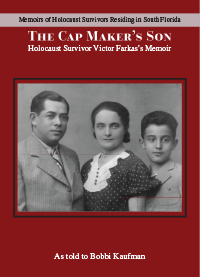
Victor had a happy childhood in his hometown of Debreen Hungary until the Nazis took over the country in 1944. His father gave him a coat with disguised gold coins as the buttons to use to bribe people if necessary. Victor was sent with his Mother to slave labor around Vienna before being sent to Mauthausen Concentration Camp where he was liberated. After the war, they escaped Soviet occupied Hungary eventually emigrating to Canada in 1951 and the United States in 1976.
Click here to view Victor Farkas' memoir.
HENRY FLESCHER
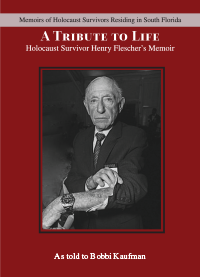
Henry Flescher was born in Vienna, Austria on March 14, 1924. After the Nazis took over Austria Henry eventually ended up in France where he was arrested and sent to slave labor in Poland spending almost three years in concentration camps before being liberated by American troops. Henry lived in Belgium after the war emigrating to the United States in 1950. He is survived by two daughters, three grandchildren and two great-grandchildren.
Click here to view Henry Flescher's memoir.
DAVID MERMELSTEIN

Born and raised in the Carpathian Mountains, David’s town was occupied by the Nazis on his Bar Mitzvah. His family was sent to Bergase Ghetto before deportation to Auschwitz where he worked in slave labor and the death march until he was liberated in Ebensee Concentration Camp. After the war he escaped Soviet occupied Slovakia eventually immigrating to the United States where he met and married a Holocaust Survivor he had met in a refugee soup kitchen in Europe.
Click here to view David Mermelstein's memoir.
FRED MULBAUER
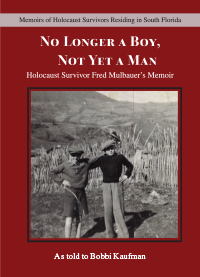
Fred Mulbauer was born in Stava, Czechoslovakia on December 28, 1929. In the spring of 1944, after confinement in the Uzhhorod ghetto, Fred’s family spent five days locked in a crowded cattle car with no food, water or sanitation. In 1948, Fred joined the American Friends of Haganah and served in Israel for 18 months. He returned to America and served in the Marines during the Korean War. In New Jersey, Fred built his business as a watchmaker and a jeweler. He married and had two daughters. After his wife passed away in 2001, Fred moved to Miami Beach.
Click here to view Fred Mulbauer's memoir.
ADDITIONAL HOLOCAUST SURVIVOR MEMOIRS
ALBERT ACKERSTEIN
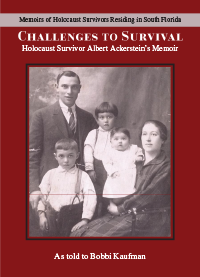
Along with tens of thousands of other Polish refugees fleeing from the Nazis, Albert and his brother crossed into Russia where they were picked up, locked in a cattle car, and endured a two week long journey to Siberia where they would spend the next two years at forced labor in the Siberian forest.
When the war ended, the brothers trekked home bartering haircuts for food and shelter. They then spent years in a displaced persons’ camp before immigrating to the United States. Never wanting to see snow ever again, Albert moved to Miami Beach where he married, raised a family, and had a successful career as a barber.
Click here to view Albert Ackerstein's memoir.
BIANCA PERLMUTTER LERNER
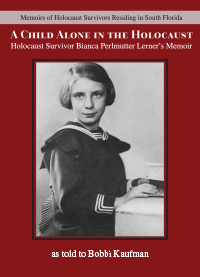
When Bianca was ten years old, her family moved into the Warsaw Ghetto. After three years, Bianca was smuggled out of the ghetto and would spend the next two years hiding in a Catholic orphanage. Passing as a Christian, Bianca joined the Polish underground during the Polish Insurrection. When the Insurrection failed, Bianca was taken as a Nazi prisoner of war. She was marched from camp to camp until she was eventually liberated by the British at Bergen Belsen. She is the only one of her family to survive the Holocaust. In 1946 Bianca emigrated to the United States where she married and raised two children.
Click here to view Bianca Perlmutter Lerner's memoir.
HERBERT KARLINER
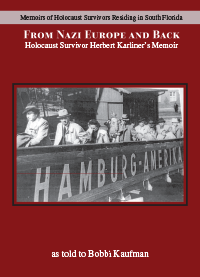
Seeking refuge from Nazi horror after their grocery store was destroyed on Kristallnacht, the Karliner family booked passage on the MS St. Louis sailing from Hamburg, Germany, to Cuba. Denied entry to Cuba, the United States, and Canada, the ship returned to Europe where the family was granted temporary asylum in France. Herbert and his brother were housed in Society for Assistance to Children (OSE) homes and then hidden in the forest until liberation. Their parents and sisters died in Auschwitz.
Herbert went to work for the OSE searching for Jewish children who had been hidden on farms and in convents during the war. He also worked as a translator and teacher for the Four-hundred boys liberated from Buchenwald. Eli Wiesel was one of his ‘boys.’ In Miami, Herbert became a successful baker - a trade he learned as a child laborer in France. He and his wife have two daughters.
Click here to view Herbert Karliner's memoir.
ISSAC KLEIN
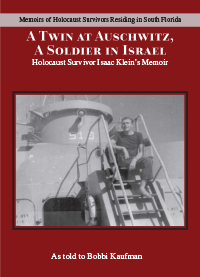
Isaac Klein and his twin brother were born i their family’s farm in Czechoslovakia in 1931. When Hitler’s troops occupied Czechoslovakia and stripped Jews of citizenship, Isaac’s family lost their home and their livelihood. They were relocated to the Satoraljauhley Ghetto and then to Auschwitz. On arrival at the camp, Isaac and his twin brother were immediately selected by the infamous Joseph Mengele for medical experimentation. Surviving surgeries, lashings, and near starvation, Isaac then endured a 700 kilometer death march to Mathausen where he was liberated by the Americans. Isaac and his brother, now orphans, made their way to Palestine. In 1948 seventeen-year-old Isaac joined the Israeli Army and fought in Israel’s War of Independence. He served in the Israeli military and in the Merchant Marine for several years before emigrating to the United States with his wife and sons.
Click here to view Issac Klein's memoir.
LASZLO SELLY

Laszlo’s family was forced into a designated Jewish house, known as a Yellow Star House, in the Budapest Ghetto. From their window, Laszlo watched thousands of Jews being marched down the street to the trains to Auschwitz. When Laszlo’s father obtained a Raoul Wallenberg certificate of protection, the family moved to a so-called safe house. From there Laszlo listened to the screams as Jews were murdered on the banks of the Danube River.
After liberation, Laszlo and his twin brother completed their education in Hungary under intense communist indoctrination. The brothers escaped from Hungary during the 1956 Revolution and made their way to New York where Laszlo became a successful photographer, a profession he studied in Hungary.
Click here to view Laszlo Selly's memoir.
LEO MARTIN
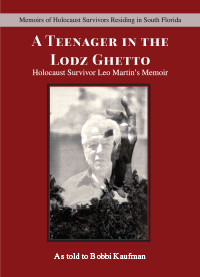
Leo Martin was fifteen years old when his family was locked into the Lodz Ghetto. Following the liquidation of the ghetto, Leo and his family were among the handful of Jews still alive. Leo was first assigned to gather the personal belongings of those Jews who had been killed or deported. Then he became a grave digger, digging the eight big graves intended for the remaining Jews in the ghetto; including himself and his young sister. When Leo got word that the Russians were crossing the Vistula River, he and his family went into hiding in a hole he had prepared under the morgue in the Lodz cemetery. On January 19, 1945 the family was liberated by the Russians.
Following liberation, while waiting to go to Palestine, Leo learned that Canada was looking for skilled laborers. He emigrated to Canada where he met and married Gloria Kaufman. They raised a son and two daughters. Leo built a very successful international furniture company.
Click here to view Leo Martin's memoir.
MENDEL ‘MANNY’ RIBA & SALLY TOLUB RIBA
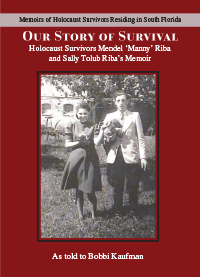
Manny Riba was a prisoner in Prokocim Labor camp where he worked cleaning the streets after the liquidation of the Krakow Ghetto. From Prokocim he was sent to Skarzysko labor camp, then by cattle car to Buchenwald, and finally by death march to Theresienstadt where he was liberated by the Russians.
Sally Tolub Riba grew up in Sosnowiec, Poland. During the war she worked sewing uniforms for the German army. From the Srodula Ghetto she was sent to Trautenau labor camp where she did slave labor until liberation by the Russians.
Manny and Sally met and married in Poland in 1945. They emigrated to the United States where they raised their daughter and two sons.
Click here to view Manny Riba's memoir.
ISRAEL JOE SACHS
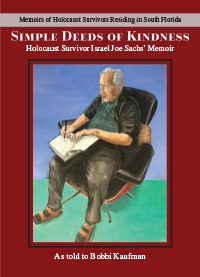
In 1942 sixteen-year-old Joe was arrested in the Sosnowiece Ghetto and spent the next two years digging trenches, laying sewer pipes, and hauling cement in Nazi labor camps. He would then endure three death marches, transport by cattle car, and imprisonment in Gross-Rosen and Goerlitz concentration camps before being liberated by the Americans.
In a DP camp after liberation, Joe married Maniusa Mell, a survivor of Auschwitz, Ravensbruck, and Bergen Belsen. In 1949 they emigrated to the United States where they raised their son and daughter.
Click here to view Israel Joe Sachs' memoir.
SALOMON WAINBERG
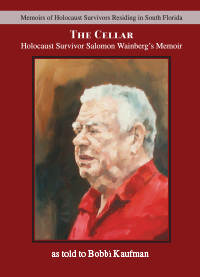
Escaping from the Zelechow Ghetto in 1942, Salomon’s family would spend the next two years hiding in a farmhouse cellar. Twenty-four people would live in the dark, damp, eleven by eighteen foot cellar for two years until one day the trap door opened and Polish bandits began shooting. Salomon’s sister was shot.
When Salomon’s father begged the Poles to allow him to bury his daughter, the family escaped and hid in the fields for six weeks until liberation by the Russians. Solomon was eight years old. In 1947 the family emigrated to Costa Rica. Salomon completed his education at the University of Miami where he met his wife. Together they raised their son and daughter.
Click here to view Salomon Wainberg's memoir.
YITZHAK WAKSAL
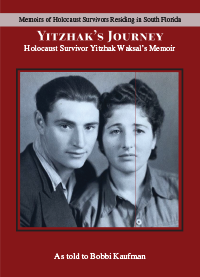
Yitzhak watched as the Nazis burned down his synagogue and torched its fifteen Torah scrolls in September 1939. His family would spend the next year in the Jedlinsk Ghetto before being sent to forced labor camps. At one camp, while kneeling by a mass grave waiting to be shot, Yitzhak escaped and ran into the forest. He survived the war hiding in the forest for eight months.
After liberation Yitzhak married and he and his wife spent five years in a DP camp in Germany before emigrating to the United States where they raised their three children.
Click here to view Yitzhak Waksal's memoir.








 Holocaust Memorial Miami Beach, a Committee of the Greater Miami Jewish Federation
Holocaust Memorial Miami Beach, a Committee of the Greater Miami Jewish Federation